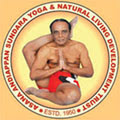Starting date
|
1st to 18th Nov 2013
|
Duration
|
The course runs full-time for 18 days.
|
Eligibility
|
Students are required to have a minimum of three months’ regular yoga practice in order to attend this course.
|
Syllabus
|
Theory:
- Yogic View of Anatomy and Physiology
- Tridhosa, Marmas, Nadis, Doshas, and Vayus
- Principles & Methods of Yoga Therapy and Their Application
Practicals:
- Application of Pranayamas, Kriyas, Mudras, and Bandhas in Yoga Therapy
- Natural Healing Methods
- Basic Sequencing Methods and Precautions in Yoga Therapy for Various Ailments
|
Daily Class Schedule
(Note: Classes and teachers may change without notice.)
|
6:00-7:00AM
|
Yogic Kriyas
|
7:00-9:30AM
|
Andiappan Yoga with Guruji
|
10:30AM-12:00PM
|
Yoga Theory & Discussion
|
3:00-5:00PM
|
Yoga Theory & Practicals
|
6:00-7:00PM
|
Yoga Practicals, Application, and Teaching Methods
|
|
This course is best suitable for
|
- Yoga practitioners, Yoga Therapists,
- Physiotherapists, Sports Therapists, Physical Education Teachers, and Fitness instructors of all levels
- Practitioners who are looking for a solid foundation in yoga therapy and its applications
- Those interested in designing yoga therapy programmes that cater to different individuals’ needs and capabilities
- Those interested in practising yoga therapy for the treatment of their own injuries and ailments
|
What you will learn in this course
|
- Anatomy and physiology in yoga therapy and their applications and practices
- A detailed study of the body’s elements and constitution
- Principles of yoga therapy and their application for common ailments
- Natural therapy techniques and the yogic diet
- Precautions and contra-indications of Asanas, Kriyas, Mudras, Bandhas, and Pranayamas
|
Faculty (Scheduled according to their availability)
|
The following members of the faculty are scheduled to teach according to their availability.*
1.Guruji Dr. Asana Andiappan,
Founder and Chairman of Asana
Andiappan Yoga and Natural Living Development Trust
2.Yogananth Andiappan,
Founder and Director, Anahata Yoga, Hong Kong. Guruji's son.
3.Dr. Vishnu Kumar
Chief Yoga Therapist
4.Master Narayana Ayyappan
Chief Yoga Instructor, Inner Glow Yoga
* Faculty might change according to their availability.
|
Accommodation
|
Outstation participants shall arrange their own accommodation.
(All help and guidance will be provided by us)
|
Food
|
Participants are required to follow a strict Vegetarian diet
|
Course fee
|
Rm 6,500/-
Early Bird discount of RM500/- for registrations before 30 Sept 2013
The course fee is inclusive of the tuition, course materials and certification.
|
How to apply
|
The class is limited to 30 students per batch.
Prospective applicants should confirm their enrollment at least one month in advance of the course starting date (by 1st Oct, 2013 ), by making a 30% non-refundable deposit.
|
What to bring
|
We provide all course materials.
You may bring your own set of loose and comfortable yoga outfits and yoga mat.
(Yoga mats also available for sale at our centre)
We also expect an open, willing-to-learn mindset.
|
Required reading
|
- Thirumoolar’s Ashtanga Yoga by Dr. Asana Andiappan
- Yoga Therapy by Banglore Sundaram
- Simple Yoga for Health by Dr. Krishnamoorthy
- Asana - International Yoga Journal
A separate Course Manual/Notes and Charts will be given to students at the beginning of the course.
The above reading materials can be bought from our on line yoga store.
|
Certification
|
After completing the 200 Hours Yoga Therapy Teacher Training Course, students will be required to undergo a Theory and Practical examination.
Questions on yoga therapy and its applications will be asked during the exam.
Students who successfully pass the exam will receive a Course Graduation Certificate, accredited by :-
1. Asana Andiappan College of Yoga and Research Centre, Chennai, India,
2. International Yoga Academy (RYS 200 & 500 and ERYT 500), Hong Kong, and
3. Yoga Alliance USA.
We also offer assistance to students who wish to apply for Yoga Alliance Registration after completing the course.
|
What next?
|
- Contact Inner Glow Yoga, No 4A, Lorong Rahim Kajai, T.T.D.I, Kuala-Lumpur @ 0129069616 / 0169704470. Or email us at innerglowyogattdi@gmail.com /
- Our faculty will assess your application and confirm your admission within three working days.
- Once your application is approved, you will be required to make a 30% non-refundable deposit to confirm your enrollment. This can be done via an online transaction or bank transfer or deposit.
- The remaining 70% of the fee to be paid 1 month before the course commences (By 1st Oct, 2013)
|
Cancellation/
Refund Policy
|
Students may cancel their enrollment 15 days prior to the course’s commencement and get a 70% refund if they have already paid the course fee in full.
All bank charges incurred in the process shall be borne by the student.
However, the 30% deposit made in confirmation of the student’s enrollment is strictly non-refundable.
Cancellation within 7 days of the course’s start date will incur a cancellation fee equivalent to 50% of the total course fee.
No refund will be made once the course has begun.
|
Additional Inclusions in Course Fee
|
Free Yoga classes for Two months at Inner Glow Yoga, Kuala Lumpur.
|



